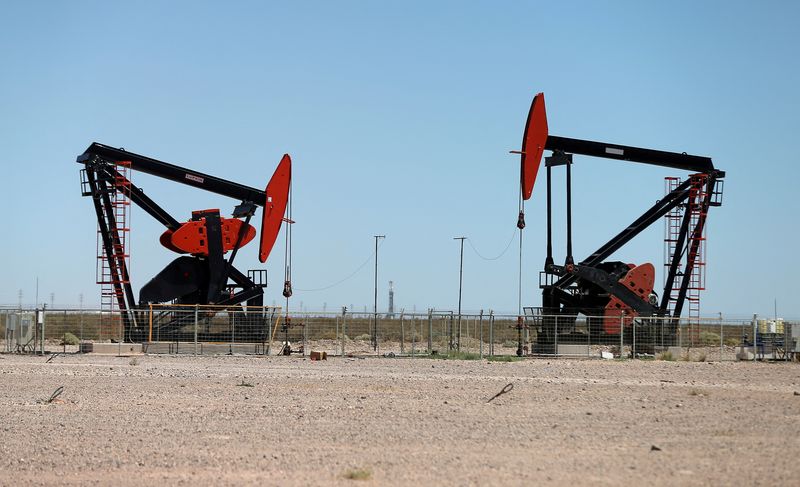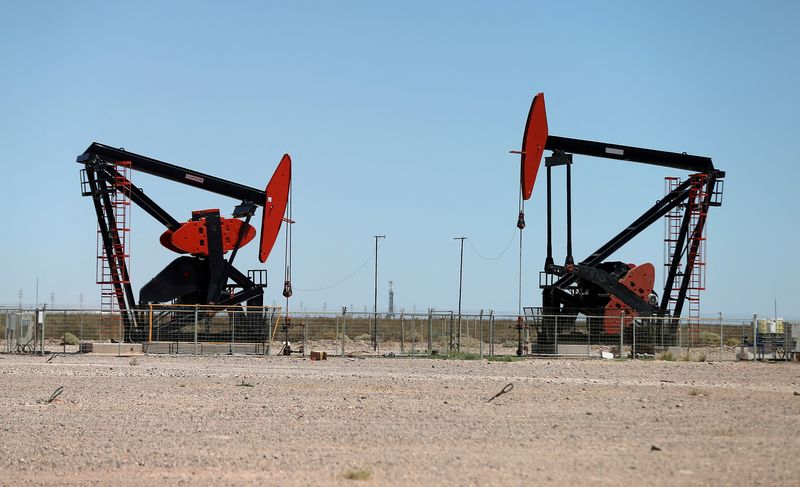Commodities
Oil falls as concerns about China outweigh extended cuts


© Reuters. FILE PHOTO: Oil pump jacks are seen at the Vaca Muerta shale oil and gas deposit in the Patagonian province of Neuquen, Argentina, January 21, 2019. REUTERS/Agustin Marcarian/File Photo
By Ahmad Ghaddar
LONDON (Reuters) – Oil prices eased on Thursday as an uncertain economic outlook for China outweighed expectations of tighter supplies from extended supply cuts in Saudi Arabia and Russia.
futures fell 42 cents, or 0.5%, to $90.18 a barrel by 1029 GMT, while U.S. West Texas Intermediate crude (WTI) futures fell 52 cents, or 0.6% to $87.02.
Both benchmarks had spiked earlier in the week after Saudi Arabia and Russia, the world’s top two oil exporters, extended voluntary supply cuts to the year-end. These were on top of the April cuts agreed by several OPEC+ producers running to the end of 2024.
Market participants also digested mixed data from China. Overall exports fell 8.8% in August year on year and imports contracted 7.3%. But crude imports surged 30.9%.
“The wind has been taken out of the bulls’ sail overnight by rising Chinese product exports last month albeit crude oil imports rose,” PVM Oil analyst Tamas Varga said.
Concerns about rising oil output from Iran and Venezuela, which could balance out a portion on cuts from Saudi and Russia, kept a lid on the market as well.
“At present, it is really difficult for us to see any negative factors due to supply constraints,” said CMC Markets (LON:)’ Shanghai-based analyst Leon Li.
“However, we need to consider possible demand risks such as in the fourth quarter, the market could slow into an off peak season for oil consumption after summer demand ends.”
Helping support prices, {{8849|U.S. crcrude oil inventories were projected to have fallen by 5.5 million barrels in the week ending Sept. 1, according to market sources citing American Petroleum Institute figures. [API/S]
Official inventory data from the U.S. Energy Information Administration is due at 11 a.m. EDT (1500 GMT) on Thursday.
Commodities
Oil prices rise; U.S. crude inventories plunge, Russia-Ukraine truce eyed
Commodities
India’s Reliance to stop buying Venezuelan oil over US tariffs, sources say
Commodities
Oil prices climb on Venezuela supply worries

 Forex3 years ago
Forex3 years agoForex Today: the dollar is gaining strength amid gloomy sentiment at the start of the Fed’s week

 Forex3 years ago
Forex3 years agoUnbiased review of Pocket Option broker

 Forex3 years ago
Forex3 years agoDollar to pound sterling exchange rate today: Pound plummeted to its lowest since 1985

 Forex3 years ago
Forex3 years agoHow is the Australian dollar doing today?

 Cryptocurrency3 years ago
Cryptocurrency3 years agoWhat happened in the crypto market – current events today

 World3 years ago
World3 years agoWhy are modern video games an art form?

 Commodities3 years ago
Commodities3 years agoCopper continues to fall in price on expectations of lower demand in China

 Economy3 years ago
Economy3 years agoCrude oil tankers double in price due to EU anti-Russian sanctions























